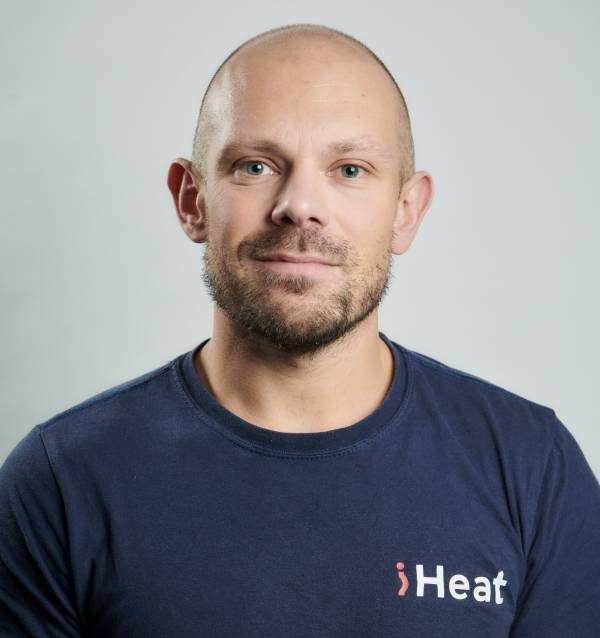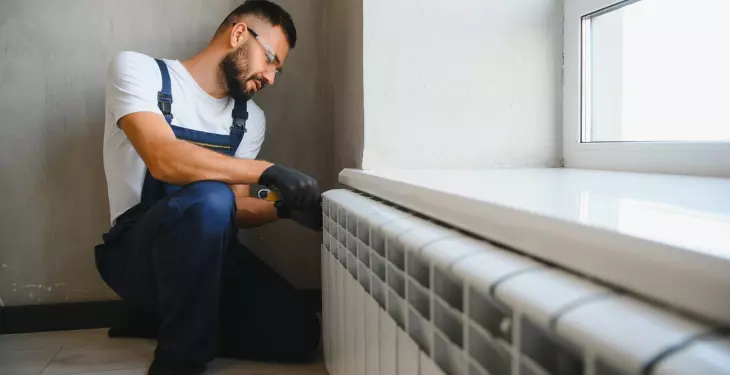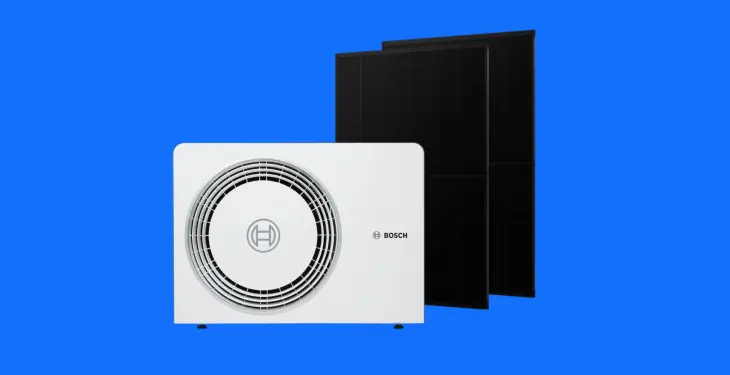

Written by Stephen Day
Gas Safe Engineer
Updated: 30th May, 2025
Retrofitting a heat pump replaces or supplements traditional heating methods with modern, energy-efficient technologies. This process can enhance energy savings and improve comfort in the home.
See how much you could save with a heat pump quote.
Transforming homes to incorporate heat pumps is more than just a trend; it’s a commitment to a future powered by renewable energy. As the UK inches closer to its net-zero goals, retrofitting existing homes with heat pumps emerges as a viable and sustainable solution. Retrofitting heat pumps provides not just an avenue for reducing carbon emissions but also offers low-carbon heating solutions that promise long-term benefits for homeowners.
Embarking on this retrofit journey involves a balance between embracing new technology and understanding practical aspects like planning, design, and location. Many homes might require adjustments such as enhanced insulation or new pipework to achieve optimal efficiency. Though changes might seem daunting, these efforts lead to sustainable living and reduced energy bills over time.
Homeowners keen on integrating heat pumps must weigh potential disruptions and necessary finishes against the significant advantages offered. With various types, maintenance considerations, and warranties to explore, making informed decisions is possible. This move not only aligns with environmental goals but also enhances the comfort and value of the home.
Retrofitting involves upgrading or modifying an existing structure or system. In homes, this can include changing heating, ventilation, and insulation systems.
Retrofitting a heat pump replaces or supplements traditional heating methods with modern, energy-efficient technologies. This process can enhance energy savings and improve comfort in the home.
This approach often requires adaptations to existing setups. For example, renovation of plumbing and heating systems can be necessary. Homes with narrow pipework may need larger pipes to optimise heat pump efficiency.
Steps involved in retrofitting a heat pump:
Assessment: Evaluate current heating needs and system capabilities.
Design: Plan a system tailored for the home.
Installation: Implement the new heat pump, possibly adjusting existing infrastructure.
Retrofitting isn’t just about replacing equipment. It's about rethinking how a home uses energy. With the UK's push for eco-friendly solutions, retrofitting is a growing trend.
Benefits include reduced energy bills and increased property value. Challenges can involve initial costs and possible disruptions during installation.
Planning is a critical step when retrofitting heat pumps in existing homes. Installing a heat pump might require changes to the home’s heating infrastructure, such as pipework and radiators. Larger pipes, like 28mm diameter, can help improve efficiency. An assessment of existing systems can guide necessary adjustments.
Building regulations are key considerations. They ensure installations meet safety and energy efficiency standards. Homeowners should consult with professionals to navigate these requirements. This step is essential to ensure compliance and optimal performance.
Addressing installation costs is vital. Costs vary, influenced by the type of heat pump and property specifics. Government schemes like the Boiler Upgrade Scheme and ECO4 can provide financial assistance, making the transition more affordable.
Homeowners may need to check if planning permission is required. In some cases, heat pumps can be installed under permitted development rights, meaning formal permission isn't needed. It's advisable to verify with local authorities.
Accurate planning can lead to long-term savings and increased energy efficiency. Engaging heating engineers for personalised advice can optimise the project. Carefully considering these factors will result in a smoother retrofit process.
Designing a heat pump system for existing homes involves several key considerations. Energy efficiency is a major focus, as optimisation can lead to significant cost savings. Homes may require additional insulation or energy efficiency measures to reduce heat loss.
A heat loss calculation is essential in the design phase. This calculation helps determine the required capacity of the heat pump to effectively heat the home. The process involves evaluating factors such as window types, insulation levels, and building orientation.
When retrofitting, consider the type of heat pump. Air source heat pumps are often more suitable for existing homes due to their ease of installation compared to ground source systems.
Pipework and radiators may need upgrades to accommodate the new system. Large bore pipework, typically 28mm or larger, supports efficient heat distribution and is ideal when switching from gas boilers fitted with smaller pipes.
For homes with existing solar panels, integrating these with the heat pump can enhance energy savings. This combination harnesses solar energy to power the heat pump, reducing dependency on grid electricity.
Radiator and underfloor systems also contribute to design decisions. High-temperature heat pumps can be paired with existing radiators, minimising costly upgrades and changes. Designing the system with these points in mind ensures compatibility with existing heating components.
Overall, a well-thought design considers energy efficiency, system compatibility, and building specifics to successfully integrate a heat pump into an existing home.
The location of your home plays a significant role in determining whether it is suitable for a heat pump. In urban and suburban areas, space might be limited, affecting the options for outdoor units. This is especially relevant for air source heat pumps (ASHPs), which require external placement to function efficiently.
In rural locations, homes typically have more space available. This can be advantageous for installing both air-to-air and ground source heat pumps. Ground source heat pumps (GSHPs) require land for the underground piping system, making them ideal for properties with large gardens.
Proximity to neighbours is another factor. Noise levels from ASHPs can be a concern in closely-built areas. Manufacturers have improved technology to reduce noise, but it's essential to consider this when planning installation locations.
For homes in colder regions, the performance of the heat pump can be affected. Air source heat pumps are less efficient at extremely low temperatures. Therefore, assessing the climate is important to ensure the system meets heating demands.
Existing homes in conservation areas or listed buildings may face restrictions on modifications. Planning permissions might be needed, particularly for visible outdoor units. Homeowners should check local regulations to avoid potential issues.
Key Points to Consider:
Land availability: Essential for GSHPs.
Space constraints: Affects ASHP placement.
Local climate: Influences heat pump efficiency.
Neighbour proximity: Consider noise levels.
Regulatory factors: Building or modification restrictions.
Ensuring the chosen heat pump suits both the property's location and the local environment is crucial for a successful retrofit.
Insulation is a critical factor when retrofitting heat pumps in existing homes. Homes need to maintain warmth efficiently, and effective insulation helps reduce heat loss. Without proper insulation, the benefits of a heat pump can diminish significantly.
Older homes often face challenges with thermal performance. Walls, roofs, and windows can allow heat to escape. External wall insulation and loft insulation can greatly improve heat retention. These methods help keep energy bills lower and improve comfort.
Double glazing for windows is another effective strategy. It acts as an additional barrier against heat loss. By replacing single-pane windows with double or even triple glazing, homeowners can enhance the thermal efficiency of their buildings.
For optimal performance, homes must be assessed for potential upgrades. This includes checking insulation levels in the walls, loft, and floors. The goal is to ensure that heat produced by the pump remains inside the house as much as possible.
A simple list of key insulation areas to consider includes:
Walls: External wall insulation can prevent heat escape.
Roofs: Loft insulation can stop warm air from rising and leaving.
Windows: Double glazing provides an extra layer of protection.
Investing in these upgrades before installing a heat pump can ensure better efficiency. Ensuring proper insulation is essential for making a heat pump retrofitting project successful.
Retrofitting heat pumps in existing homes involves changes to the pipework. Homes with older systems might need updates or replacements to ensure efficient heat pump operations. This often involves changes in pipe size and system compatibility.
When retrofitting a heat pump, the installation of new pipework is often necessary. Standard UK homes with gas boilers typically use small pipes. These are often less than 15mm in diameter. Heat pumps, on the other hand, require larger pipes. Pipes over 28mm in diameter allow for better efficiency and flow.
Including larger radiators or underfloor heating helps heat pumps work more effectively. This upgrade can improve the heat distribution and efficiency of the system. Installing new pipework may also involve altering existing structures to fit larger pipes and maintain optimal space heating.
Retrofitting heat pumps into existing homes can cause noticeable disruption. This usually involves installing new pipework and possibly modifying existing systems. Homes with traditional gas boilers often have small pipes, which may require changes to support the new, efficient systems of heat pumps.
Homeowners might need to plan for changes to their living spaces. For instance, larger radiators or underfloor heating could be necessary to ensure efficient heat distribution. These modifications can lead to temporary but significant upheaval within homes.
Certain installations might demand insulation upgrades. This is because heat pumps work efficiently in well-insulated homes, which may mean installing additional insulation or improving existing layers. This work can disturb daily routines.
A significant advantage of heat pumps is that high-temperature models can work with current radiators. This feature minimises disruption, reducing the need for extensive overhauls. Many homeowners appreciate this option as it cuts down both the time and cost involved.
During the installation, the outdoor unit must be placed appropriately. This involves exterior work that might include landscaping changes, particularly for homes with limited outdoor space. Proper planning can ease these disruptions.
When retrofitting heat pumps, the finishes chosen can greatly impact the aesthetics and functionality of the system. Selecting the right finishes ensures that retrofits blend seamlessly into existing homes without compromising style.
In older buildings, maintaining the architectural integrity is often a priority. Radiators, for example, can be updated with modern designs that still complement traditional interiors. It's vital to ensure that new pipework, often required for heat pumps, is discreetly integrated.
Homeowners may consider underfloor heating for a sleek finish. This not only enhances comfort but provides an invisible heating solution, perfect for minimalist designs.
Pipework Finishes: Modern installations often use sleek coverings or paint to match existing decor. Large bore pipes required by some heat pump systems should be strategically placed to remain unobtrusive.
Wall Finishes: Whether repainting or adding wallpaper, it's important to choose finishes that withstand temperature changes. Insulation upgrades, common in heat pump installations, may necessitate redecorating, which provides an opportunity to refresh interior aesthetics.
External units of heat pumps should be carefully situated to reduce visual impact. Options include landscaping to screen units or placing them in less visible areas of the home.
A well-planned retrofit considers both function and form, ensuring that heat pumps not only perform effectively but also enhance the living environment.
Heat pumps are an efficient way to heat homes, using renewable energy from air or ground. The choice of heat pump depends on property characteristics and heating needs.
Air source heat pumps (ASHPs) extract heat from the outside air. Even in cold weather, they can efficiently provide heating and hot water. There are two main types: air-to-water and air-to-air.
Air-to-water heat pumps connect to existing wet central heating systems and can work with traditional radiators or underfloor heating. They are suitable for a variety of properties, especially those with good insulation.
Air-to-air heat pumps, on the other hand, deliver warm air directly into the home. They can also provide cooling in the summer, functioning like an air conditioner. Installation is generally straightforward, but these systems do not produce hot water, which can be a drawback for some households.
Ground source heat pumps (GSHPs) are another popular choice. They use underground pipes to extract heat from the ground. This type of system requires more space for installation compared to air source systems, typically needing a garden or suitable outdoor area for laying pipes.
The efficiency of GSHPs is often higher as the ground maintains a more consistent temperature throughout the year. They are an excellent choice for homes where space permits their installation. These pumps can be paired with existing heating systems or as part of a hybrid system—combined with other renewable technologies like solar panels or biomass boilers. This can enhance efficiency and lower energy bills further.
Maintaining a heat pump is essential for its efficient operation. Regular inspection is recommended at least once a year by a qualified heat pump engineer. This can help identify any potential issues early and prolong the system's life.
Filter cleaning is a simple task. Homeowners should clean or replace filters every 1-3 months. This ensures optimal airflow and efficiency.
Regular checks on the outdoor unit prevent debris build-up. Leaves and dirt can obstruct airflow, impacting performance. Keep the area around it clear for best results. This is an easy task for most homeowners.
For more complex maintenance, hiring an MCS certified heating engineer is advised. They provide assurance of quality and expertise. They can check electrical connections, refrigerant levels, and overall system performance.
Annual maintenance visits by professionals may also uncover issues that a homeowner might miss. This keeps the system reliable during cold months. Consistent checks and professional services contribute to energy savings and system longevity.
Routine maintenance not only avoids unexpected breakdowns but can also lead to cost savings on energy bills by ensuring the system is running efficiently.
When retrofitting heat pumps into existing homes, understanding the warranty offered by manufacturers and installers is key. Warranties vary in duration, scope, and coverage.
Typical Warranties
Heat Pump Units: Manufacturers often provide a warranty of 5-10 years. This usually covers parts and labour for any potential defects in the system.
Installation Work: Some installers might offer their own warranties on the work performed, sometimes up to 2 years.
It is important to evaluate what is included in the warranty. Coverage for the heat exchanger, compressors, and electrical components should be confirmed.
Conditions for Warranty
Warranties often require regular maintenance. It's vital to follow any prescribed service schedules. Non-compliance might invalidate warranties.
Consider checking if the system and installer are accredited by the Microgeneration Certification Scheme (MCS). MCS certification can sometimes extend warranty options and provide additional consumer protections.
Exceptions and Exclusions
Not all damage is covered. Check for exclusions like user error or environmental damage. It's recommended to read the warranty documents carefully before installation.
Discuss any unclear points with the installer. Proper documentation and an understanding of warranty terms can offer peace of mind.
Last updated: 30th May, 2025

Written by Stephen Day
Gas Safe Engineer at iHeat
Stephen Day is a Gas Safe registered and FGAS certified engineer with over 20 years of hands-on experience in the heating, cooling, and renewable energy industry, specialising in boiler installations, air conditioning, and heat pump systems.
LinkedInArticles by Stephen Day are reviewed by iHeat’s technical team to ensure accuracy and reliability.

05th December, 2025
Most homes need some radiators upgraded for a heat pump, but usually not all of them.
 Read Article
Read Article

05th December, 2025
Most homes can lower heating costs by combining air source heat pumps with solar panels.
 Read Article
Read Article

28th November, 2025
High temperature heat pumps work like boilers without needing radiators, but they cost mor...
 Read Article
Read Article
No obligation. Takes less than 60 seconds.